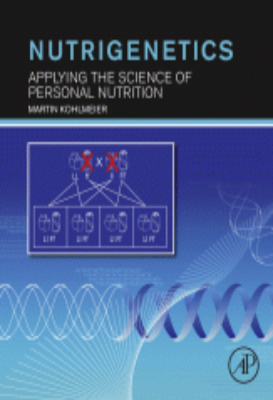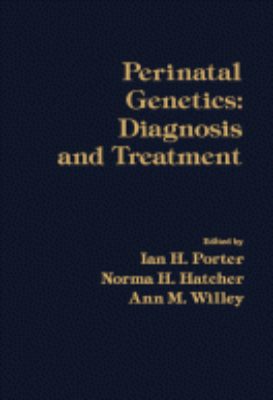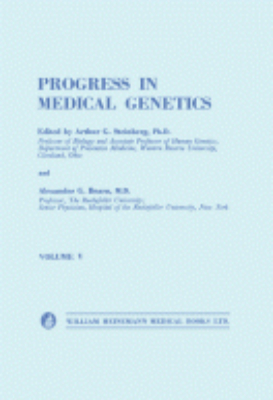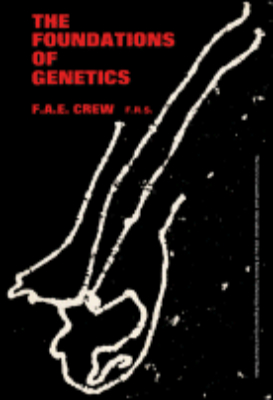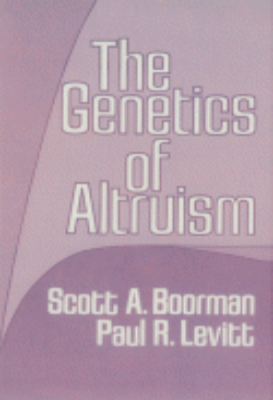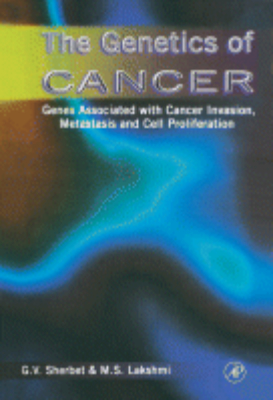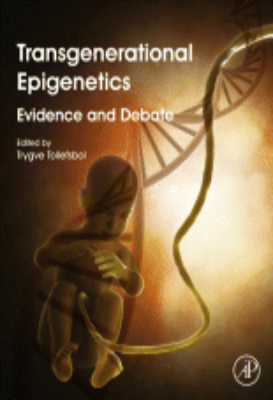E-Resources
Molecular Genetics
Molecular Genetics, Part III: Chromosome Structure explores the structure and modification of DNA, chromatin, and higher order organization and possible subunits of chromosomes at the molecular level. It describes major changes in concepts of chromatin structure and packaging of DNA based on studies of nuclease digests and electron micrographs; the role of restriction endonucleases in molecular genetics; the involvement of DNA topoisomerases in concerted breaking and rejoining of DNA backbone bonds; enzymatic methylation of DNA; and transcriptional units in eukaryotic chromosomes. Organized into seven chapters, this volume begins with an overview of the general properties of type I and type II restriction enzymes, basic aspects of restriction enzyme technology, and applications of restriction enzyme technology to the study of chromosome structure and function. It then discusses recombinant DNA technology; possible biological roles of DNA topoisomerases; recognition and control sequences in nucleic acids; composition and substructure of nucleosomes; analysis of chromosome fibers by electron microscopy; organization of fibers into chromosomes; and functional aspects of organization of chromosome fibers. Molecular biologists, geneticists, scientists, and electron microscopists will find this book extremely helpful.
Molecular Genetics of Sex Determination
In this era of accelerated discovery and prolific output, Molecular Genetics of Sex Determination keeps readers abreast of this fields fast-moving biology. Its chapters were completed by experts in eacharea only months before publication. The text is organized into two parts. First, it reviews the basic biology of sex determination and summarizes ground-breaking work in mouse, marsupial, and Drosophila systems. Second, it covers current human genetics, clinical studies, and the syndromes of abnormal sex differentiation. With chapters by preeminent reproductive biologists, this is a capital work. Ohno's law is described by Ohno; the Lyon hypothesis, by Lyon; Sinclair tells how he cloned the testis-determining gene; and so on. Molecular Genetics of Sex Determination is authoritative, comprehensive, and current. It is prime reading for geneticists, developmental biologists, graduate students in these and related fields, clinical researchers, physicians, and medical students.
Molecular Genetics: 2000
Molecular Genetics, Part II covers the significant developments in various areas of molecular genetics. This book is composed of 10 chapters that also consider the gene expression and regulation of some enzymes. The opening chapters deal with the mechanisms of nucleic acid replication and repair, as well as the structural aspects of the genetic apparatus of viruses and cells. The next chapters explore the patterns and mechanisms of genetic recombination, the in vitro and in vivo experiments to delineate the genetic code, and the initiation of peptide chains in Escherichia coli. These topics are followed by discussions of the mechanism of DNA-dependent RNA synthesis, the regulation of enzyme synthesis in microorganisms, and the regulation of viral replication. The final chapters consider the theoretical and practical aspects of the metabolic regulation in metazoan system and the procedures for the study of DNA-DNA and DNA-RNA interactions. This book will be of great value to molecular geneticists, biochemists, and researchers.
Nutrigenetics
Nutrigenetics: Applying the Science of Personal Nutrition provides a fully referenced, readable guide to understanding the rationale and importance of nutrigenetic applications and explains why single nutrition recommendations will not fit everybody or even a majority of modern humans. This books explains how genetic variation shapes individual nutrition requirements and sensitivities, presents questions to ask about reported gene-nutrient interactions, and what needs to be done before putting nutrigenetic tests to practical use. This book blends key concepts from the fields of genetics, biochemistry, epidemiology, public health, and clinical medicine to give a rich perspective on the genetically diverse nutritional needs and sensitivities of individuals in health and disease. A steadily increasing number of people order genetic tests to find out what they should eat for better health, well being and performance, and an even greater number asks their healthcare providers about such tests. Most of the currently offered tests are not grounded in current knowledge, often absurdly so, but few professionals can explain why they are misguided. On the other hand, there are more evidence-supported genetic variants that can guide nutrition decisions, but again most healthcare providers know little about them, much less use them in their daily practice. There is a great need for a solidly evidence-based yet accessible book that explains the science of nutrigenetics and provides the tools to evaluate new nutrigenetic tests.
Opioid Peptides: Biology Chemistry and Genetics
The Peptides: Analysis, Synthesis, Biology, Volume 6: Opioid Peptides: Biology, Chemistry, and Genetics presents a biological topic of peptide research. This book is divided into nine chapters. Chapter 1 reviews the opioid peptide precursors and their genes. The proenkephalin and products of its processing are discussed in Chapter 2. In Chapter 3, the role of pro-opiomelanocortin (POMC) as a protein at the interface of the endocrine and nervous systems is examined. Chapter 4 provides a comprehensive account of the biology and chemistry of the dynorphin peptides. The opioid receptors are described in Chapter 5. Chapter 6 evaluates the structure-activity relationships of -endorphin, while Chapter 7 considers the conformational analysis of enkephalins and conformation-activity relationships. The structure-activity relationships among enkephalin peptides are elaborated in Chapter 8. The last chapter is devoted to the clinical significance of opioid peptides in humans. This publication is a good reference for biologists, specialists, and researchers concerned with peptides and proteins.
Perinatal Genetics
Perinatal Genetics: Diagnosis and Treatment brings together the proceedings of the 15 Annual New York State Health Department Birth Defects Symposium held on September 30-October 1, 1984 in Albany, New York. The symposium provided a forum for clarifying and rationalizing certain aspects of diagnosis and treatment of perinatal genetic birth defects such as fragile X syndrome, phenylketonuria, and hypothyroidism. Comprised of 17 chapters, this book begins with an epidemiological review of very early pregnancy loss, focusing on fertilization and implantation; the probability of loss between fertilization and implantation (on about the sixth day), and between implantation and the 14th day (the first day of the expected next period in a non-pregnant woman); and the contribution of chromosomal errors in the sperm, ovum, and zygote to early reproductive loss. The reader is then introduced to cytogenetic abnormalities in spontaneous abortions of recognized conceptions; repetitive spontaneous abortion; and prenatal genetic diagnosis by chorionic villus sampling. Subsequent chapters explore prenatal treatment of biochemical disorders; in vitro fertilization and embryo transfer; and moral issues concerning third trimester pregnancy terminations. This monograph will appeal to perinatologists, neonatologists, obstetricians, pediatricians, and geneticists and should also serve as a useful guide for health professionals who provide care to pregnant women and their newborns.
Personalized Epigenetics
Personalized Epigenetics discusses the core translatability of epigenetics to health management of individuals who have unique variations in their epigenetic signatures that can guide both disorder and disease prevention and therapy. The book details inter-individual variability in the major epigenetic process in humans consisting of DNA methylation, histone modifications, and noncoding RNA, and the diagnostic, prognostic, and therapeutic potential of the field, it also reviews the impact of the environment on epigenetic variations among individuals and the role of pharmacology and drug development in personalized epigenetics. Most importantly, the text covers personalized epigenetics from a disease-oriented perspective, presenting chapters that provide advances in widespread disorders or diseases, including diabetes, cancer, autoimmune disorders, obesity, cardiovascular diseases, neurological disorders, and pain management.
Physiological Genetics
Physiological Genetics is a compilation of developments, contributed by experts in the field of physiological genetics. The articles contained in the book covers various accounts of developments in the field. The book starts with an introductory chapter describing genetic factors in developmental gene regulation, followed by discussions on enzyme differentiation, hormonal control of gene expression, biochemical genetics of morphogenesis, cytoplasmic male sterility in maize, plant somatic cell genetics, and the population dynamics of genetic polymorphism. Physiologists, biologists, geneticists, and students will find a valuable reference material.
Plant Improvement and Somatic Cell Genetics
Plant Improvement and Somatic Cell Genetics includes all but one of the papers presented at two symposia held during the XIII International Botanical Congress in Sydney, Australia, on August 21-28, 1981. ""Frontiers in Plant Breeding"" and ""Cell Culture and Somatic Cell Genetics in Plant Biology"" highlight the ways in which plant breeding techniques can improve crops. The book explores the potentials as well as the limitations of plant breeding, and cellular and molecular techniques in plant improvement. Comprised of 14 chapters, this volume begins with an overview of the potential applications of exotic germplasm for tomato and cereal crop improvement. It continues with a discussion of multiline breeding, breeding of crop plants that can tolerate soil stresses, combining genomes by means of conventional methods, use of embryo culture in interspecific hybridization, use of haploids in plant improvement, and somaclonal variation and somatic hybridization as new techniques for plant improvement. The reader is also introduced to plant cell culture, as well as somatic cell genetics of cereals and grasses, somatic cell fusion for inducing cytoplasmic exchange, uses of cell culture mutants, genetic transformation of plant cells by experimental procedures in the context of plant genetic engineering, and use of molecular biology techniques for recognition and modification of crop plant genotypes. This book will be a useful resource for scientists and plant breeders interested in applying somatic cell genetics for crop improvement.
Population Genetics and Ecology
Population Genetics and Ecology is a collection of papers presented at a 1975 conference-workshop held in Israel and is devoted to topics in population genetics and ecology. Contributors discuss topics related to population genetics and ecology, including the determinants of genetic variation in natural populations; experimental design and analysis of field and laboratory data; and theory and applications of mathematical models in population genetics. The book describes a number of field and laboratory studies that focus on a variety of spatial and temporal character and enzyme frequency patterns in natural populations, along with possible associations between these patterns and ecological parameters. This volume is organized into three sections encompassing 31 chapters and begins by summarizing the results of field and laboratory research that investigated gene frequency patterns in space and time of animal and plant populations. This book then explains the origin of new taxa; animal and plant domestication; variation in heritability related to parental age; and problems in the genetics of certain haplo-diploid populations. The next section offers a combination of data analyses and interpretations of related models, with some papers devoted to the origin of race formation and the interaction between sexual selection and natural selection. Among the theoretical studies presented are facets of selection migration interaction; stochastic selection effects; properties of density and frequency dependent selection; concepts and measures of genetic distance and speciation; aspects of altruism; and kin selection. This book will be of interest to naturalists, experimentalists, theoreticians, statisticians, and mathematicians.
Practical Guide to Neurogenetics-key
This simple guide to neurogenetics demystifies the overwhelming amount of information on the subject so you can identify key clinical features and understand your management options. Reach relevant differential diagnoses and provide appropriate counseling to your patients using the symptom-based approach. By integrating genetic and neurological approaches to diagnoses, this book ensures that the neurological consequences of a genetic diagnosis and the genetic consequences of a neurological diagnosis are clear and explicit. Concise and portable, this book is ideal for easy reference in clinical use.
Principles of Developmental Genetics
Providing expert coverage of all major events in early embryogenesis and the organogenesis of specific systems, and supplemented with representative clinical syndromes, Principles of Developmental Genetics, Second Edition discusses the processes of normal development in embryonic and prenatal animals, including humans. The new edition of this classic work supports clinical researchers developing future therapies with its all-new coverage of systems biology, stem cell biology, new technologies, and clinical disorders. A crystal-clear layout, exceptional full-color design, and bulleted summaries of major takeaways and clinical pathways assist comprehension and readability of the highly complex content.
Progress in Medical Genetics
Progress in Medical Genetics: Volume 5 covers the improvements in nutrition and control of childhood disease. This book is divided into five chapters that evaluate the characteristics of thalassemias, an inherited defect in hemoglobin. It addresses the genetic control of hemoglobin synthesis and the clinical pictures and nomenclature of the different porphyrias. Some of the topics covered in the book are the genetic aspects of liver disease connected with jaundice; development of the concept of thalassemia as a hemoglobinopathy; bilirubin metabolism; description of hemolytic jaundice; description of hyperbilirubinemia. The succeeding chapters describe the disturbances in bilirubin uptake and conjugation, as well as the clinical diagnosis of familial non-hemolytic hyperbilirubinemias. An analysis of the Dubin-Johnson and Rotor syndrome is provided. The last chapters consider the genetics of muscular and the analysis of autosomal dominant forms of muscular dystrophy. The book can provide useful information to doctors, endocrinologists, students, and researchers.
The Evolution of Genetics
The Evolution of Genetics provides a review of the development of genetics. It is not intended as a history of the science of heredity. By a brief and general survey, however, it seeks to show the connections of past to present research, and of current discoveries to future investigations. The book opens with a chapter on the legacy of classical genetics. This is followed by separate chapters on the use of microorganisms in molecular genetics; the structure and replication of genetic material; mutation and recombination of genetic material; the heterocatalytic function of genetic material; and concludes with a discussion of the future of genetics. Undergraduates considering a career of teaching or research in biology, students who are embarking on graduate studies in biology, professional biologists working in fields other than genetics but interested in current research on heredity, and laymen who have had some education in biology and have a continued interest in biological science may find something useful in this book.
The Foundations of Genetics
The Foundations of Genetics describes the historical development of genetics with emphasis on the contributions to advancing genetical knowledge and the various applications of genetics. The book reviews the work of Gregor Mendel, his Law of Segregation, and of Ernst Haeckel who suggested that the nucleus is that part of the cell that is responsible for heredity. The text also describes the studies of W. Johannsen on "pure lines," and his introduction of the terms gene, genotype, and phenotype. The book explains the theory of the gene and the notion that hereditary particles are borne by the chromosomes (Sutton-Boveri hypothesis). Of the constituent parts of the nucleus only the chromatin material divides at mitosis and segregates during maturation. Following studies confirm that the chromatin material, present in the form of chromosomes with a constant and characteristic number and appearance for each species, is indeed the hereditary material. The book describes how Muller in 1927, showed that high precision energy radiation is the external cause to mutation in the gene itself if one allele can mutate without affecting its partner. The superstructure of genetics built upon the foundations of Mendelism has many applications including cytogenetics, polyploidy, human genetics, eugenics, plant breeding, radiation genetics, and the evolution theory. The book can be useful to academicians and investigators in the fields of genetics such as biochemical, biometrical, microbial, and pharmacogenetics. Students in agriculture, anthropology, botany, medicine, sociology, veterinary medicine, and zoology should add this text to their list of primary reading materials.
The Genetics of Altruism
The Genetics of Altruism covers the primary findings on social evolution, social trait, and altruism from a population genetics standpoint to establish a system of genetic boxes. It presents an evolutionary question with two faces: Why are there so many social species Why, in all the diversity of the animal kingdom, are the social species so few To address the evolutionary question, this book focuses on recognition of the fact that on an evolutionary time, scale genetics must underlie all changes in the capacity for social structure and other aspects of organic evolution. It presents comparative analyses framed in mathematical terms; mathematical concepts as a means of getting outside human, perhaps more generally primate and carnivore; frames of reference; and alternative network combinatorics as a natural basis for comparing social structures that are phylogenetically remote. It also discusses the comparative biology of social behavior on a purely descriptive basis through the social and evolutionary structures emergent. The book concludes by discussing major evolutionary pathways, various kinds of preadaptedness for sociality, and the use of cascade principle to suggest ways in which human evolution may have been a special case. This book is a valuable resource for biologists, social scientists, researchers, students, and all those who want to broaden their knowledge in the field of social behavior and altruism.
The Genetics of Cancer
Written by internationally recognized experts, The Genetics of Cancer provides up-to-date information and insight into the genetic basis of cancer and the mechanisms involved in cancer invasion and its secondary spread. This volume presents the deregulation of the cell cycle in tumor development and integrates the function of tumor suppressor genes, oncogenes, and metastasis-associated genes in the pathogenesis and progression of cancer. The Genetics of Cancer will be useful to all graduate students, clinicians, and researchers working in the fields of cancer biology, genetics, and molecular biology.
The New Genetics of Mental Illness
The New Genetics of Mental Illness is a collection of papers that discusses the advancement of molecular biology in the context of psychiatry. The book presents papers that are organized thematically. The text first discusses the basics of biology and quantitative models, and then proceeds to covering linkage analysis. Next, the book deals with various mental disorders, including schizophrenia, eating disorders, and developmental disorders. The remaining materials turn their attention to dementia and Huntingtons disease. The book will be of great use to researchers and practitioners of behavioral sciences, such as psychology and psychiatry.
Transgenerational Epigenetics
Transgenerational Epigenetics provides a comprehensive analysis of the inheritance of epigenetic phenomena between generations. Recent research points to the existence of biological phenomena that are controlled not through gene mutations, but rather through reversible and heritable epigenetic processes. Epidemiological studies have suggested that environmental factors may be heritable. In fact, environmental factors often play a role in transgenerational epigenetics, which may have selective or adverse effects on the offspring. This epigenetic information can be transferred through a number of mechanisms including DNA methylation, histone modifications or RNA and the effects can persist for multiple generations. This book examines the evolution of epigenetic inheritance, its expression in animal and plant models, and how human diseases, such as metabolic disorders and cardiovascular diseases, appear to be affected by transgenerational epigenetic inheritance. It discusses clinical interventions in transgenerational epigenetic inheritance that may be on the horizon to help prevent diseases before the offspring are born, or to reduce the severity of diseases at the very earliest stages of development in utero, and current controversies in this area of study, as well as future directions for research.






